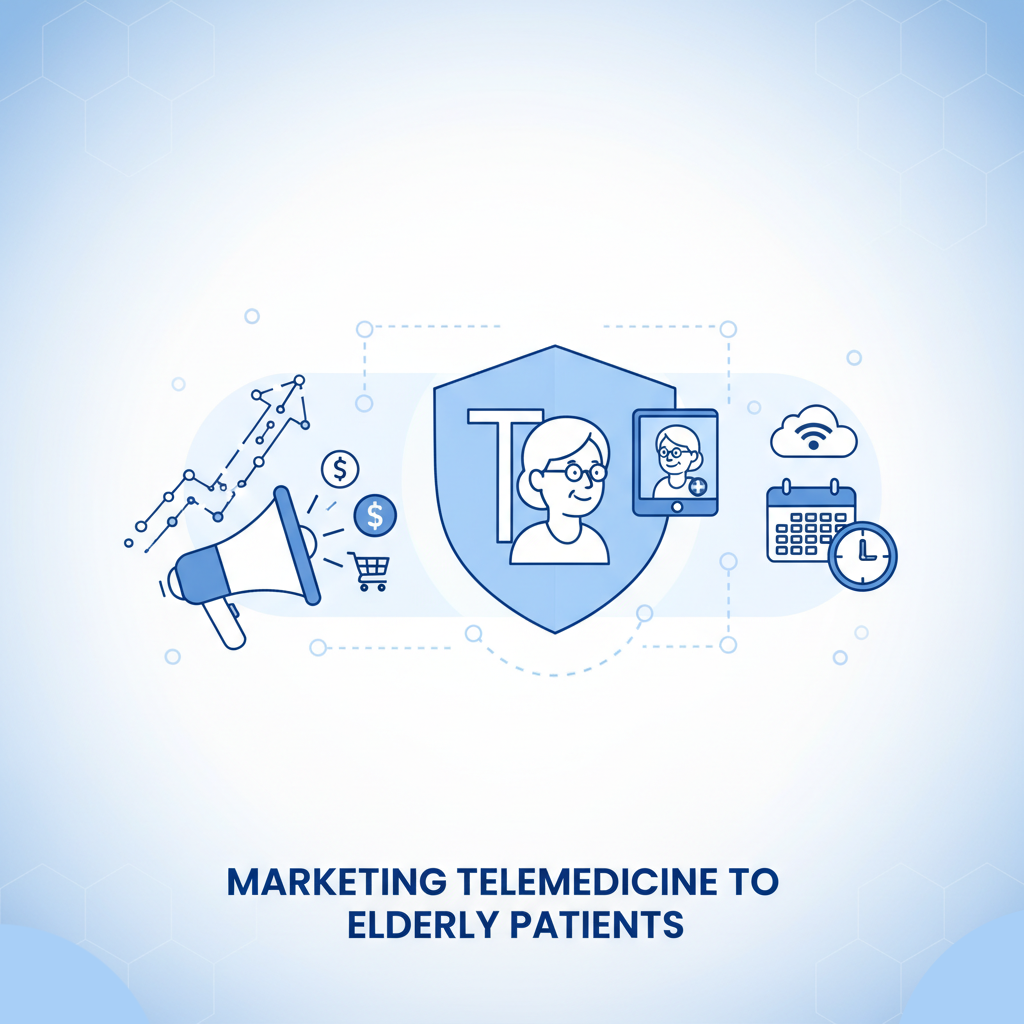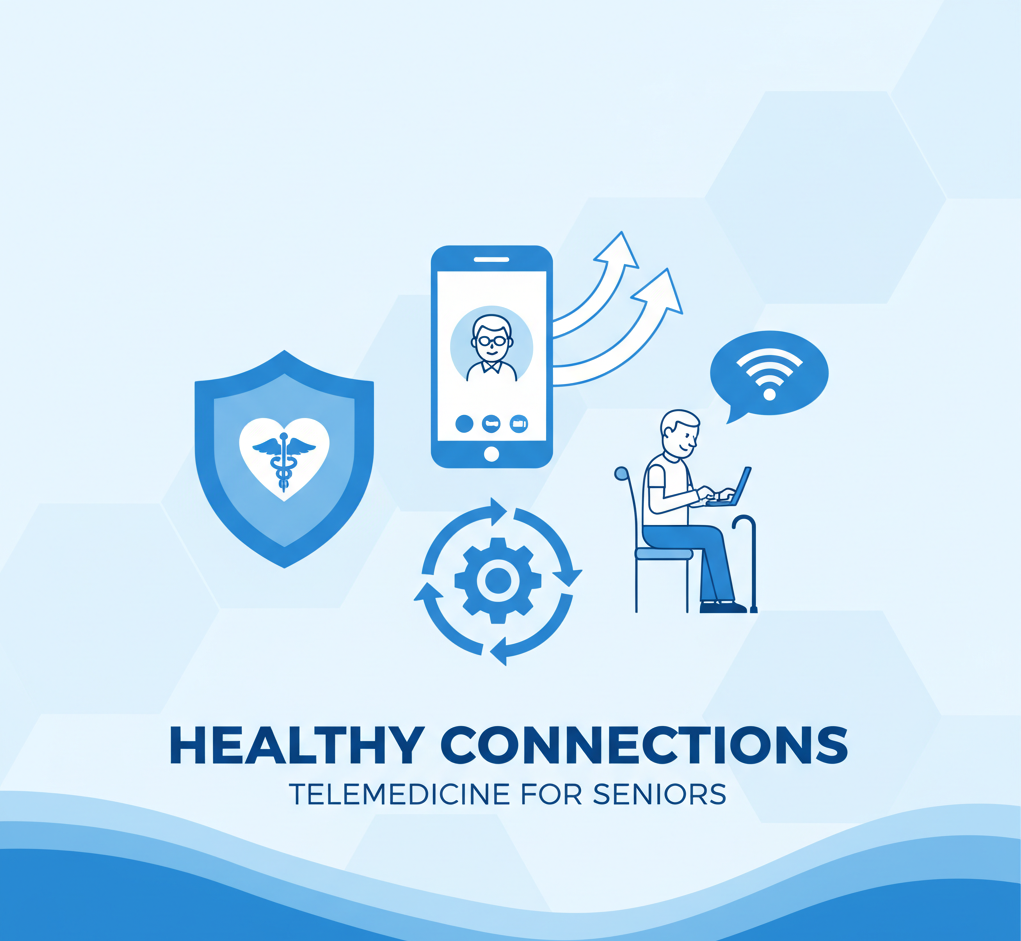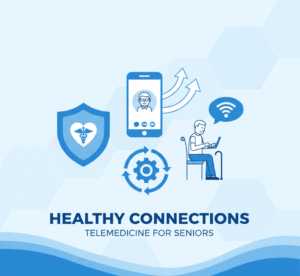“Unlock telehealth adoption by effectively marketing telemedicine to elderly patients and their caregivers with clear, trust-building, and simple multi-channel campaigns.”
The rise of telehealth has been one of the most significant shifts in modern healthcare. For many, the ability to consult a doctor from the comfort of home is a game-changer. However, one of the demographics that stands to benefit the most—senior citizens—is often the most challenging to reach. For healthcare providers, the question is not whether virtual care is valuable for older adults; rather, it is whether it is effective. The question is: how do you effectively communicate that value and drive adoption?
Marketing telemedicine to elderly patients differs from marketing a new streaming service or a smartphone. It requires a nuanced approach built on a foundation of trust, simplicity, and a deep understanding of not only the patient but also their entire support network. This is not about flashy digital ads with confusing tech jargon. It is about meeting seniors where they are, speaking their language, and addressing their core concerns head-on.
Many organizations make the mistake of assuming seniors are a monolithic, tech-averse group. This is not true. The reality is far more complex. Some seniors are active on Facebook, comfortable with video calls to see their grandchildren, and manage their finances online. Others have never touched a smartphone and rely entirely on family members for help with any digital tasks.
A successful telehealth marketing strategy recognizes this diversity. It focuses on bridging the gap between incredible technology and the people who need it most. It involves clear communication, robust educational resources, and a clever digital strategy that often targets the “hidden” healthcare decision-makers: their adult children and caregivers. This guide will walk you through the actionable steps needed to build a campaign that resonates, builds confidence, and successfully integrates virtual care into the lives of your senior patients.
Understanding Your Audience: Seniors Are Not a Single Demographic
Before you can craft a single piece of marketing material, you must first abandon the stereotype of the technology-fearing senior. The modern senior population is incredibly diverse in its digital literacy. To create an effective campaign, you need to segment this audience and understand their unique needs and motivations.
1. The “Young-Old” (Ages 65-74)
This group often defies the traditional mold of senior citizens. Many are recently retired, still active, and have been using technology for years. They likely own a smartphone, use email regularly, and are active on social media platforms like Facebook to stay in touch with family.
- Marketing Approach: For this segment, your messaging can be more direct and digitally focused. They understand the concept of a video call. The key is to highlight the convenience. Frame telehealth as an innovative, efficient way to manage their health without disrupting their active lifestyle. Emphasize benefits like “no travel time,” “no crowded waiting rooms,” and “quick prescription refills from home.” They are more likely to respond to email campaigns, website banners, and even well-targeted social media content.
2. The “Old-Old” (Ages 75-84)
This demographic may have a broader range of technological comfort. Some might be just as savvy as their younger counterparts, while others may use technology only for specific tasks or require assistance with it. They are often managing one or more chronic conditions, making consistent medical care essential.
- Marketing Approach: Trust and familiarity are paramount here. The message should come from a source they already trust—their primary care physician. Their motivation is less about lifestyle convenience and more about safety and accessibility. Highlight benefits such as “avoiding the risk of infection at a clinic,” “easy follow-ups after a procedure,” and “managing your chronic condition without a difficult trip to the office.” This group benefits immensely from printed materials and in-person explanations.
3. The “Oldest-Old” (Ages 85+) and the Caregiver Connection
For this group, technology can be a significant barrier. They are also the most likely to have mobility issues or complex health needs that make traveling to appointments burdensome. Crucially, their healthcare decisions are very often made in partnership with, or entirely by, an adult child or a dedicated caregiver.
- Marketing Approach: This is a two-pronged strategy. You must provide simple, clear information for the patient, but your primary marketing target is the caregiver. The caregiver is the one who will set up the device, download the app, and initiate the call. Therefore, your marketing efforts must directly address their needs. Their pain points include taking time off work for appointments, the physical strain of transporting their parent, and the stress of managing complex care schedules. Your message to them is one of relief and empowerment.
Recognizing these distinctions is the first step. You are not just selling a service; you are providing a solution that must fit into different lifestyles, comfort levels, and family dynamics.
The Foundation of Your Campaign: Building Unshakeable Trust
In healthcare, trust is the ultimate currency. For senior patients who have spent a lifetime visiting their doctor in person, the idea of a “virtual visit” can feel impersonal, insecure, or simply strange. Before you can explain how telehealth works, you must first explain why it is a safe and trustworthy option. Your entire campaign must be engineered to build and reinforce this trust.
Leverage Your Most Powerful Asset: Your Doctors
The single most trusted voice in a senior’s healthcare journey is their own doctor. A message from a generic hospital administrator about telehealth will be ignored. The same message, delivered by Dr. Smith, whom they have known for 20 years, becomes a credible recommendation.
- In-Person Endorsements: Train your physicians and nurses to be telehealth advocates. During a regular in-person visit, they can say something like, “For our next follow-up, we can do a simple video call so you do not have to worry about the traffic. Our staff can show you exactly how it works before you leave today.” This personal invitation is compelling.
- Doctor-Led Videos: Create short, simple videos featuring your practice’s doctors. Have them look directly at the camera and explain, in simple terms, what a virtual visit is and why they believe it is an excellent option for their patients. This personalizes the technology and connects it to a familiar face.
Show, Do not Just Tell, with Patient Testimonials.
Peer validation is a potent tool. Seeing someone “like me” successfully using a new service can dismantle fear and skepticism faster than any brochure.
- Create Relatable Video Stories: Find a few of your senior patients who have had a positive telehealth experience and ask them to share their story on camera. A short video of an 80-year-old named Margaret saying, “I was nervous at first, but it was so easy! I just clicked a link on my tablet and there was my doctor. It was wonderful not having to get a ride to the clinic,” is worth more than a mountain of marketing copy. These videos are perfect for your website, waiting room TVs, and social media.
Address Security Concerns Simply and Directly
Seniors are often rightly concerned about their privacy online. You must address this head-on, but without using confusing technical jargon.
- Use Simple Analogies: Avoid terms like “end-to-end encryption” or “HIPAA-compliant platform.” Instead, use language that is easy to grasp. For example: “Your video call with the doctor is completely private and secure. Think of it like a locked, soundproof room—only you and your doctor are inside.”
- Create a “Safety & Privacy” Handout: A simple, one-page document with a large font that clearly states your commitment to their privacy can be a reassuring takeaway from a clinic visit.
Offer a “No-Pressure” Tech Trial
One of the biggest anxieties is the fear that the technology will fail during the actual appointment. You can eliminate this fear by offering a risk-free trial run.
- Schedule a Tech Check-In: Have a friendly administrative staff member or a “telehealth navigator” schedule a five-minute practice call with the patient one to two days before their actual appointment. This allows them to test their camera and microphone, see how the platform works, and ask any questions in a low-stakes environment. This small step can dramatically increase patient confidence and reduce day-of-appointment no-shows due to tech issues.
Ultimately, every piece of your campaign should reinforce the message that this new technology is merely a different door to the same trusted care they have always received.
Crafting the Message: Simplicity Is King
When marketing to older adults, clarity always trumps cleverness. Your messaging needs to be direct, benefit-oriented, and completely free of medical or technical jargon. The goal is to make the concept of telehealth feel as approachable and straightforward as a phone call.
Focus on Benefits, Not Features
Do not sell the technology; sell the outcome. Your patients do not care about the name of your software platform or its “synchronous communication capabilities.” They care about what it does for them.
- Feature-Focused (Bad): “Our practice now offers a state-of-the-art telehealth platform with integrated EMR and patient portal access.”
- Benefit-Focused (Good): “See Your Doctor From Your Favorite Armchair. No Traffic. No Waiting Rooms.”
Here are some benefit-driven phrases that resonate with seniors and their caregivers:
- “The care you trust, now from the comfort of your home.”
- “Less travel, more time for what you love.”
- “Easy follow-up appointments without leaving the house.”
- “Stay safe at home and still get the care you need.”
- “For your family’s peace of mind.”
Words Matter: Choose Simple Language
Scrutinize every word you use. Swap out complex terms for simpler, more familiar ones.
- Instead of “telehealth” or “telemedicine,” consider using terms like “video visit,” “online appointment,” or “a doctor’s visit by video.”
- Instead of “initiate a session,” use “start your video call.”
- Instead of “download the application,” say “get the app on your phone or tablet.”
Design for Readability
Visual clarity is just as important as verbal clarity, particularly for individuals with visual impairments.
- Use Large Fonts: For all printed materials, such as brochures, posters, and direct mail, use a large, easy-to-read sans-serif font (like Arial or Helvetica) in a size of at least 14 points.
- Ensure High Contrast: Use dark text on a light background. Avoid busy backgrounds, light-colored text, and fancy, hard-to-read script fonts.
- Incorporate Whitespace: Do not cram too much information onto one page. Ample whitespace makes content less intimidating and easier to digest.
By stripping away the complexity, you make the service feel manageable. The message should convey ease and reassurance, rather than technological complexity.
The Power of Education: Making Technology Approachable
For many seniors, the biggest hurdle to telehealth adoption isn’t a lack of interest, but rather a lack of confidence. “What if I cannot figure it out?” “What if I press the wrong button?” Patient education for telemedicine is not just helpful—it is an essential component of your marketing strategy. Your job is to provide them with the tools and support they need to feel capable and in control.
1. Create Step-by-Step Video Guides
Video is the perfect medium for demonstrating a digital process. Create a library of short, slow-paced instructional videos that walk users through every single step.
- Be Incredibly Detailed: Do not assume any prior knowledge. Start from the very beginning: “First, we will open the App Store on your iPad. It is the blue icon with the letter ‘A’.” Use screen recordings so they can see exactly where to tap, and use a friendly, calm voiceover to guide them through the process.
- Break It Down: Do not try to cover everything in one long video. Create a series of short, single-topic videos:
- How to Download and Install the App
- How to Create Your Account
- How to Test Your Camera and Microphone
- How to Join Your Scheduled Video Visit
- Make Them Accessible: Host these videos on a simple, easy-to-find page on your website. Additionally, empower your staff to send direct links to these videos via text or email to patients and their caregivers ahead of appointments.
2. Develop Clear, Printed “How-To” Guides
Never underestimate the power of a physical handout. A printed guide can be kept next to the computer or tablet and referred to as needed, reducing anxiety.
- Use Large Screenshots: A picture is worth a thousand words. A large, clear screenshot of the screen should accompany each step.
- Use Arrows and Numbering: Use visual cues, such as red circles or arrows, to indicate exactly where to click. Number each step sequentially.
- Include a “Help” Line: At the bottom of the guide, in a large font, include a dedicated phone number that users can call for real-time tech support from a friendly representative at your practice. Knowing that help is just a phone call away is a massive confidence booster.
3. Host In-Person and Virtual Workshops
For some, hands-on help is the only way to build confidence.
- In-Clinic Demos: Set up a station in your waiting room with a tablet or laptop and have a staff member or volunteer available to walk patients through a mock telehealth call.
- Community Workshops: Partner with local senior centers, libraries, or assisted living facilities to host “Introduction to Video Visits” workshops. This not only educates potential patients but also positions your practice as a community-minded resource.
By investing heavily in patient education, you are sending a clear message: “We are here to help you succeed with this.” This proactive support is a form of marketing in itself, as it builds goodwill and demonstrates your commitment to accessible healthcare for seniors.

The Secret Weapon: Marketing Telemedicine to Caregivers
In many senior households, the primary user of healthcare technology is not the patient, but rather their adult child. These caregivers, often from Gen X or the Millennial generation, are digitally savvy, pressed for time, and deeply invested in their parents’ well-being. They are the ones researching doctors, scheduling appointments, and managing medications. A significant portion of your marketing efforts should be aimed directly at them.
Targeted Facebook and Instagram Ads for Adult Children
Social media advertising is incredibly effective for reaching this demographic. Facebook’s and Instagram’s ad platforms allow you to target users with remarkable precision.
- The Right Audience: You can target users based on age (e.g., 40-60), which is the prime demographic for adult children caring for aging parents. You can also target by interests, such as users who have liked pages related to “elder care,” “caregiving,” or organizations like AARP. You can even target by location to reach people in your immediate service area.
- Ad Copy That Solves Their Problem: The messaging for caregivers should focus on the benefits for them.
- “Spend less time in traffic and more quality time with Mom. Ask us about video visits for your parents.”
- “Managing your parents’ healthcare just got easier. Help them see their trusted doctor from the safety and comfort of home.”
- “Peace of mind is a video call away. Our easy-to-use telehealth service makes it simple to manage your loved one’s health.”
- Ad Creative That Resonates: Use images and short videos that show positive, stress-free interactions. A smiling senior video chatting with a doctor, or an adult child looking relieved while sitting with their parent during a virtual visit. Avoid sterile stock photos. Authenticity is key.
Content Marketing for Caregivers
Position your practice as an invaluable resource for them. Create content that helps caregivers navigate their role effectively.
- Blog Posts and Guides: Write articles with titles like:
- “A Caregiver’s Checklist for a Successful Telehealth Visit”
- “5 Ways to Help Your Parents Feel Comfortable with Technology”
- “How Virtual Care Can Reduce Caregiver Stress”
- Shareable Content: Post this content on your blog and promote it through your social media channels. When a caregiver finds a helpful article from your practice, it builds brand trust and makes them more likely to choose you for their parents’ care.
Partner with Caregiver-Focused Organizations
Connect with organizations that already have the trust of this audience.
- Build Relationships: Reach out to local home health agencies, assisted living communities, and caregiver support groups to establish connections. Offer to provide educational materials or host a workshop for their members. These partnerships can create a robust referral network.
By directly addressing the needs and challenges of caregivers, you tap into a highly motivated audience that is actively seeking solutions. They can become your biggest advocates and the driving force behind increasing telehealth adoption among your senior patients.
Do not forget the Tried-and-True: Integrating Traditional Channels.
While an innovative digital strategy is crucial, a truly effective campaign for marketing virtual care for seniors integrates both online and offline tactics. You must reinforce your message across multiple touchpoints.
- In-Office Promotion: Your clinic is prime marketing real estate. Use posters in the waiting room, distribute brochures at the front desk, and have staff wear buttons that say “Ask Me About Video Visits.”
- Direct Mail: A simple, well-designed postcard can be highly effective. Use a large font, a clear headline (“The Doctor Will See You Now… In Your Living Room!”), Moreover, direct them to a simple webpage or a phone number for more information.
- Local Media: Consider placing a small advertisement in a local community newspaper or on a local radio station with a high senior listenership. Keep the message benefit-focused and straightforward.
- Email Newsletters: For your existing online patients, a clear and concise email explaining the video visit option, along with a link to your educational resources, can be highly effective in informing them about this option.
A multi-channel approach ensures that your message is seen and heard by seniors and their caregivers, regardless of where they obtain their information.
Conclusion: Your Partner in Reaching Every Patient
Successfully marketing telemedicine to elderly patients and their families is a complex challenge. It requires a thoughtful, multi-layered strategy that goes far beyond generic advertising. It requires a deep understanding of the audience, a commitment to building trust, a focus on clear and simple education, and the ability to reach both seniors and their caregivers through a combination of traditional and highly targeted digital channels.
Executing this kind of nuanced campaign can be overwhelming for busy healthcare practices. This is where a strategic partner makes all the difference.
At InvigoMedia, we specialize in crafting targeted campaigns of this kind. We do not believe in a one-size-fits-all approach. We dig deep to understand the specific demographics you need to reach, whether it is seniors who need reassurance or their tech-savvy adult children who are looking for convenience. Our expertise lies in building comprehensive PPC (Pay-Per-Click) and Social Media campaigns that deliver the right message to the right person at the right time.
From designing Facebook ad campaigns that speak directly to the needs of caregivers to creating Google Ads that capture families actively searching for accessible healthcare solutions, we build the bridge between your services and the people who need them most. We help you navigate the digital landscape to effectively drive the adoption of modern healthcare services, ensuring no patient gets left behind.
If you are ready to connect with your senior patients and their families and unlock the full potential of your telehealth services, contact InvigoMedia today. Let us build a strategy that truly works.
FAQs: Answering Common Questions About Telehealth for Seniors
Including a frequently asked questions section in your materials can proactively address concerns and reduce anxiety.
Q: Is a video visit secure and private?
A: Absolutely. Your call with the doctor is entirely private and secure, just like an in-person visit. We use technology that ensures only you and your healthcare team can be in the “room.”
Q: Do I need a special computer or fancy equipment?
A: No. A video visit can work on most computers with a webcam, as well as on tablets (such as an iPad) and smartphones. If you can video chat with your family, you can have a video visit with your doctor.
Q: What if I have technical problems during my call?
A: Do not worry! We have a dedicated support line that you can call immediately if you encounter any issues. A friendly staff member will walk you through the solution. We also offer a quick practice call with you before your first appointment to ensure everything is working perfectly.
Q: Will my insurance cover a virtual visit?
A: Most insurance plans, including Medicare, now cover telehealth visits just like they cover regular office visits. Our staff can help you confirm your coverage before your appointment.
Q: Can I use a video visit for any medical issue?
A: Video visits are perfect for many situations, like follow-up appointments, managing chronic conditions, reviewing lab results, and addressing common illnesses. However, for emergencies or issues that require a physical exam, an in-person visit is still necessary. Your doctor will always help you decide which type of visit is best for your needs.
Q: I am just not very good with technology. Is this really for me?
A: We understand completely, and we designed our service to be as simple as possible. We offer step-by-step video and printed guides, and we encourage you to ask a family member or caregiver to assist you with the initial call. Our goal is to make healthcare easier for you, and we are here to help you every step of the way.













